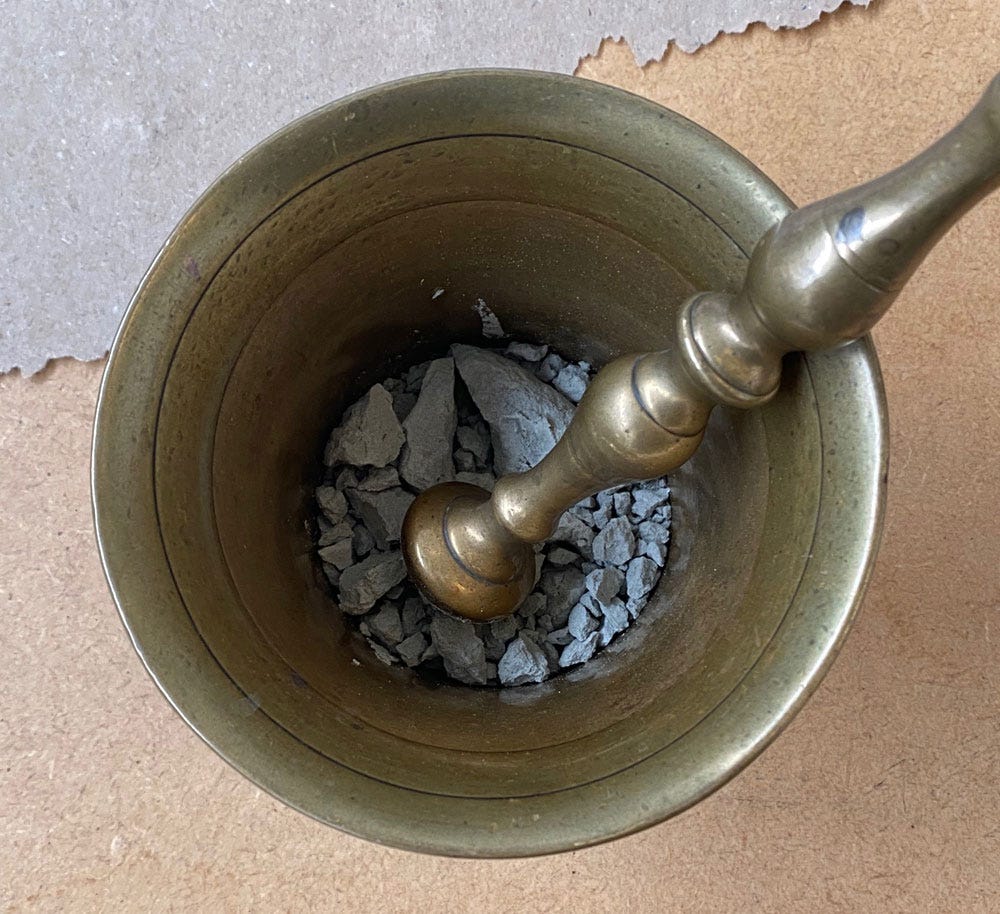I’ve just returned from far away – geographically, and even further mentally – so this week’s is a light post as I herd my thoughts and gather new contents.
Wherever I go, I like to bring back a memento; not some useless knick-knack that’s going to gather dust on a shelf but ideally something that will get used up and create no waste, like artisanal soap or a local delicacy. Better yet: something from the land, mineral or vegetal, that I can use to make art or even just make marks.
The logistics of this can be a bit tricky. Rocks are heavy to bring back, and taking the hardware to process them on the spot would be no less so (not to mention the noise and mess). Freshly picked plants and wild plant products (pine cones, bits of bark) are simply not allowed across borders, with good reason1, but the alternative is to extract their dye and lug back bottles of liquid colour. One option was open to me though, and I packed a small mortar-pestle, a little alum, and a bunch of blank clothlets.
Clothlets are a wonderful medieval device used by book artists to store delicate plant inks on pieces of cloth. These are soaked with colour, then dried and stored. When needed, a small piece is soaked in a binder and the cloth disgorges the ink. It doesn’t work for everything2 but I’m completely infatuated with this technique: You can basically travel with a full palette in a wallet.
I knew of at least one flower I could expect to find this time of year: the Douglas iris.
It so happens that iris green is a classic medieval ink, by which I don’t mean “green like an iris” but “green from an iris”. The violet and blue flowers contain pigments3 of the anthocyanin type, normally too capricious to use – but somehow iris green both looks spectacular and loves clothlets. The historically used flower is Iris germanica but I was confident that its American cousin would produce a similar result.
When I decided to gather a few flowers, I came across a whole bunch that had been freshly decapitated (probably by the local pine marten), which was ideal – no pangs of conscience!
Braying with very little water and alum extracted this glorious blue.
I judged there was enough for two clothlets, and left them there to absorb and dry.
The clothlets ready to travel… Below is what it actually looks like once applied to paper.
In the future I’d like to test out these California poppies…
… or these fabulous harlequin flowers which I encountered for the very first time. But I only gather when there is abundance, and they were simply too scarce just then.
I hadn’t intended to bring back earth pigments, but on my last day I came across a very strange pebble on the beach. It was dense but very clayey and I have no idea how it lasted in the ocean without melting; perhaps it started out as a really large lump! But how far did it travel before it ended up on a California beach?
It was unusual enough for me to pack it up so I could process it in my studio.
Bashing it was unusually easy and rather like pounding cookie dough. Washing was a doddle, with hardly any impurities to remove!
This is a quick swatch, without a binder mixed in. I love not knowing what to expect until I see it on paper. The dullest natural earth colour still manages to be complex and compelling, and this one all the more so for all the associations I have around it.
I’ll once again leave you with some intense cuteness: a few of the thousand elephant seal pups currently enjoying an extended food coma as their body grows the muscle they need to return to the sea.
They’re not just flippin’ adorable, they represent the joy of a species that survived annihilation. Due to the usual mix of human greed and cruelty, elephant seals were believed to be extinct by the late 19th century. Then a small colony of just 22 individuals was found. Left in peace4 and lovingly protected when they come to shore to give birth, they are thriving again.
The tragic story of the American ash set to be completely extinguished by the emerald ash borer, is just one heart-breaking example of what can happen when this is disregarded.
I explain the method and go into great detail about plant pigments, their chemistry and best practices in my book Wild Inks & Paints.
I call these biochromes, preferring to reserve the word “pigment” for solid colour particles.
Photo taken from behind a barrier that closes off the beach during pup season. They like staring at humans, but they like sleeping more.


















How wonderful to read more about colour from Iris! I accidentally made my first lake pigment when experimenting with my own Iris flowers - and managed to dye a small bandana green as well. (Pure luck as I didn’t know much about dye/pigments at the time.) I’ve been intrigued by the clothlets idea ever since I saw them. I’ve heard fleece works well, but yours look like a canvas style material? Off to track down your book... thank you!
Where did you find the pebble? Any conglomerate it washed out of would have clast origin profiles and I’m really curious as to what it is (as a geologist). The iris green is lovely. For your next spring trip, there are lots of poppies in non- natural settings you could collect. Thanks for show casing my state!